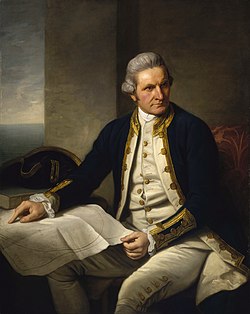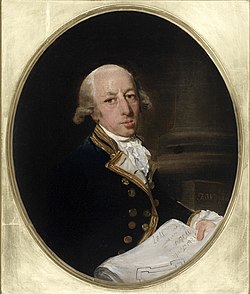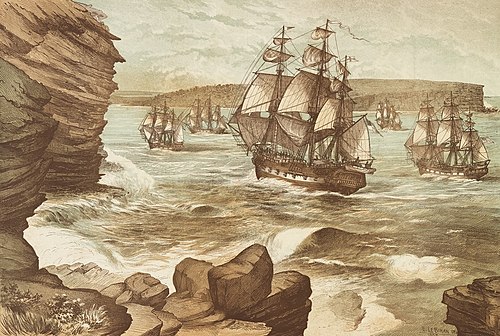The First Fleet is the name given to the first fleet of ships which arrived to Botany Bay in New South Wales in Australia on the 20th of January 1788. The expedition consisted of eleven ships, many of them carrying convicts from Britain and Ireland. 1,420 people had set out from Portsmouth in England eight months earlier, but approximately 40 people had died during the voyage. In the course of late January, the voyagers began establishing a settlement in Sydney Cove, the first stirrings of what would become the city of Sydney and the center of the colony of New South Wales. A Second Fleet would arrive in the summer of 1790 and a Third Fleet gradually over the course of the second half of 1791. With these the survival of the British colony was secured and it became the starting point of Australia, while the British in Australia would soon branch out to establish colonies on Tasmania and New Zealand as well.[1]
Research your ancestors on MyHeritage
Australia's first fleet chronology of eventsAustralia's first fleet chronology of events
Contrary to popular belief, the British explorer James Cook did not discover Australia in the middle of the eighteenth century. Europeans knew of the existence of Australia from as early as the 1640s when Abel Tasman and other Dutch explorers had explored and mapped several parts of the coast of the continent and also the island of Tasmania.[2] In the decades that followed, proposals were made in Amsterdam to merchant and colonial companies to establish a colony in what was known as New Holland, but governments and corporations alike such as the Dutch East India Company were uninterested, for the simple reason that Australia was extremely far away at the edges of the known world and did not hold out the prospect of riches in the form of gold, silver, spices or silk of the kind which had drawn Europeans to the Americas, India and the East Indies in the sixteenth century.[3]
British arrivalBritish arrival

A combination of factors emerged in the second half of the eighteenth century to convince the British government that it was time to establish a colony in Australia. First, James Cook had mapped much of the coast of New South Wales and Queensland during his Endeavour expedition between 1768 and 1771 and had also mapped New Zealand for the first time by a European.[4] On top of this, the British lost their colonies in North America in 1783 with the signing of the Treaty of Paris following the American Revolutionary War. Finally, the advent of better ships and navigational instruments in the eighteenth century meant Australia could be reached much faster than had been the case back in Tasman’s time in the 1640s. Owing to all of these developments, a decision was taken by the British government in the mid-1780s to send out an expedition to Terra Australis, as it was then known, terra meaning ‘land’ in Latin and australis being ‘southern’, ergo ‘the southern land’.[5]
First fleet passengers and crewFirst fleet passengers and crew

The First Fleet was to serve the purposes of establishing a colony in Australia for the British, and also a social purpose by ridding Britain and Ireland of hundreds of convicts. This was a continuation of a policy which had been employed in North America where tens of thousands of criminals had been sent by the British in the seventeenth and eighteenth centuries. In total the First Fleet would consist of 1,420 people, of which nearly 800 were convicts, the proportion of these being roughly three-quarters male and one-quarter female. The expedition would consist of eleven ships, nine transport ships and two military ships of the Royal Navy. It was led by Captain Arthur Phillip, who subsequently became the first governor of the New South Wales colony. Much of the remainder of the expedition consisted of sailors and crewmen on the ships or soldiers and administrators who would be charge of the colony. Many of the convicts had been sentenced to death in Britain and Ireland and in travelling as part of the First Fleet they were having their sentences commuted. They would have to carve out a new British colony in a strange land and in return their lives would be spared. The First Fleet left Portsmouth in southern England on the 13th of May 1787 and arrived in Botany Bay the following January where they began establishing Sydney and the colony of New South Wales.[6]
Extent of migration associated with australia's first fleetExtent of migration associated with australia's first fleet

As noted, the First Fleet only comprised 1,420 people and this had fallen to below 1,380 by the time the expedition arrived to Australia as forty or so people lost their lives during the voyage. On the face of it, this was a relatively limited migration, but it paved the way for a gradual trickle of Europeans to the southern continent during the 1790s and an explosion of migration in the course of the nineteenth century. The Second Fleet[7] arrived in June 1790 and consisted of five ships (a sixth never made it to Australia) carrying upwards of 800 convicts, while a Third Fleet[8] of eleven ships and approximately 2,000 convicts arrived gradually between July and October 1791. The conditions associated with these voyages were often brutal and the Second Fleet, in particular, led to hundreds of deaths during the voyages and the convicts arriving disease-ridden and ill, leading to many more deaths. Those who survived formed much of the basis for the penal colony of New South Wales in its early years.
Demographic impact of australia's first fleetDemographic impact of australia's first fleet
The First Fleet and the fleets which followed it only resulted in the arrival of a few thousand people to Australia, but their impact on world demography over time has been immense. In the early nineteenth century merchants, traders and settlers of all kinds began arriving to Australia from Europe to seek out opportunities here. The population of the New South Wales colony stood at roughly 26,000 people by 1820, while a further colony on Van Diemen’s Land, the name at the time for Tasmania, was 6,000. Often this was built on appalling treatment of the natives, especially on Tasmania where the destruction of the native population constitutes a strangely forgotten genocide.[9] By the mid-1840s, the European settler population in Australia reached 200,000, while the advent of the steamships at this time and the beginning of the Victorian Gold Rush in the early 1850s led to a population explosion, with over a million people there by 1860 and two million by 1880. It all started with the First Fleet.[10]
See alsoSee also
Explore more about Australia's First FleetExplore more about Australia's First Fleet
- Australia, New South Wales Birth Index, 1787-1916 record collection on MyHeritage
- Australia, New South Wales Death Index, 1787-1986 record collection on MyHeritage
- Settlers, Squatters and Selectors: Land ownership in Australia, 1788-1900 at Legacy Family Tree Webinars
- A Cargo of Criminals: Transportation to Australia at Legacy Family Tree Webinars
- Researching in Australian Archives at Legacy Family Tree Webinars
- Australia Day: January 26 at the MyHeritage blog
References
- ↑ https://dictionaryofsydney.org/entry/first_fleet
- ↑ https://www.worldhistory.org/article/1933/the-dutch-discovery-of-australia/
- ↑ https://www.jstor.org/stable/41555332
- ↑ https://www.bl.uk/the-voyages-of-captain-james-cook/timeline
- ↑ https://www.nla.gov.au/faq/how-was-australia-named
- ↑ https://dictionaryofsydney.org/entry/first_fleet
- ↑ https://dictionaryofsydney.org/entry/second_fleet
- ↑ https://dictionaryofsydney.org/artefact/third_fleet
- ↑ https://theconversation.com/explainer-the-evidence-for-the-tasmanian-genocide-86828
- ↑ https://www.abs.gov.au/AUSSTATS/abs@.nsf/DetailsPage/3105.0.65.0012014?OpenDocument

